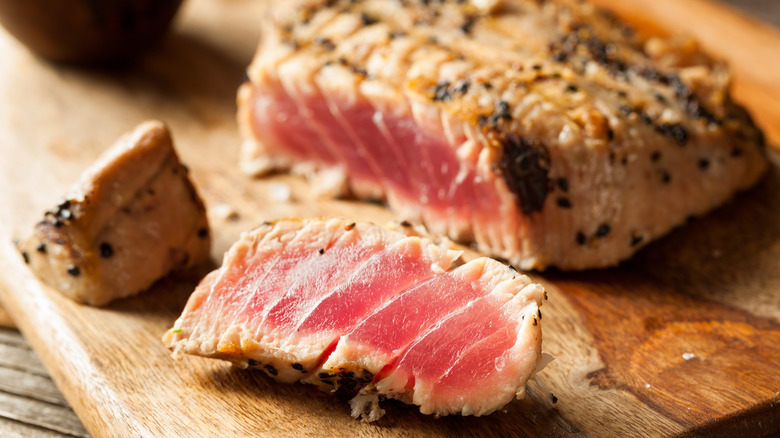Here's How Jamie Oliver Seasons Tuna Steaks
Some food is best when kept simple. Case in point – tuna steak. There's nothing quite like the succulent sweet flavor explosion that happens when you bite into a thick, perfectly cooked hunk of tuna. And Jamie Oliver, who's built his reputation on keeping things simple (and delicious), knows just how to season this silken saltwater fish to harness and accentuate its unmistakable taste and texture.
In a video on his YouTube channel, the "5 Ingredients: Quick & Easy Food" cookbook author gives the low-down on the essential spices he uses on tuna steak and how to apply them. He starts by making a four-spice rub which he calls, "a lovely, quite balanced, seasoning." The simple blend consists of 1 teaspoon of coriander seeds, 1 teaspoon of fennel seeds (he compares their flavor to aniseed), a couple of pinches of salt, and a sprinkle of pepper. Next, he mashes and mixes the spices using a mortar and pestle, stressing that you don't need to smash them until they're overly fine.
A 'very subtle' addition
To season your steaks the way the "Naked Chef" alum does, you won't apply the rub directly to the tuna, rather Oliver sprinkles the spices onto a wood-cutting board and lays the uncooked steaks on top of them, pressing down gently with his hand to help the spices stick. He repeats this on the other side and edges. "This kind of basic seasoning gives a little crust and flavoring to the tuna which is just divine — very subtle," he explains. Once the tuna is coated, add a splash of olive oil and rub it around to cover both sides.
When it's time to cook the tuna, you'll want to lightly sear the outside while leaving the center pink (unless of course, you like it well done). Chef Oliver cautions that your tuna steaks be a minimum of 2 centimeters thick to prevent overcooking. In the video, he demonstrates two tuna steak cooking methods: pan-seared and charred. Oliver notes another tip for searing tuna is that you want your nonstick grill pan " . . . screaming hot and you want it dry."
Once you've finished searing the tuna for one to two minutes on each side, remove it from the pan and add another drizzle of oil to both sides. This will help it to stay moist while it rests. In a zesty finale, the award-winning chef squeezes fresh lemon juice over the top. This tuna is so good you'll eat up every juicy morsel.

